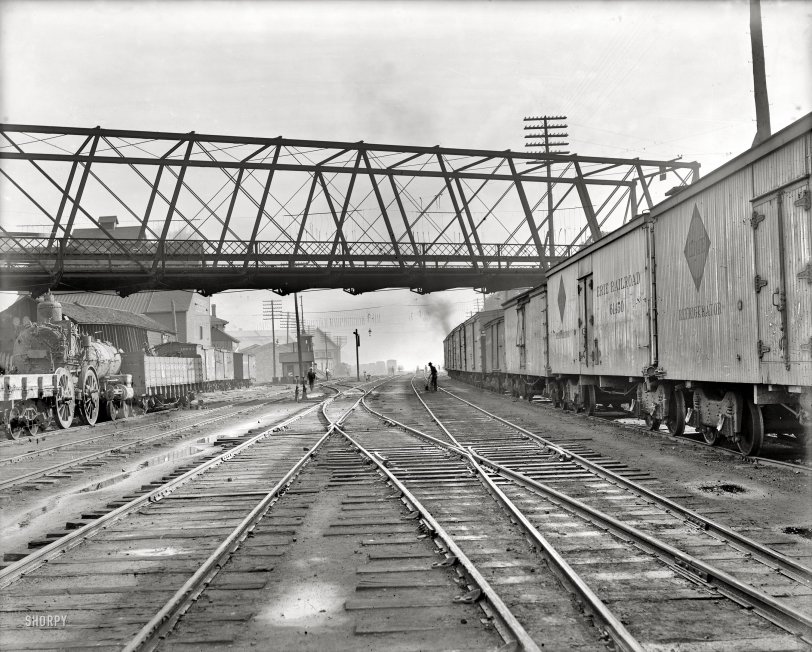


Framed or unframed, desk size to sofa size, printed by us in Arizona and Alabama since 2007. Explore now.
Shorpy is funded by you. Patreon contributors get an ad-free experience.
Learn more.

- Texas Flyer wanted
- Just a Year Too Soon
- WWII -- Replacing men with women at the railroad crossing.
- Yes, Icing
- You kids drive me nuts!
- NOT An Easy Job
- I wonder
- Just add window boxes
- Icing Platform?
- Indiana Harbor Belt abides
- Freezing haze
- Corrections (for those who care)
- C&NW at Nelson
- Fallen Flags
- A dangerous job made worse
- Water Stop
- Passenger trains have right of way over freights?
- Coal
- Never ceases to amaze me.
- Still chuggin' (in model form)
- Great shot
- Westerly Breeze
- For the men, a trapeze
- Tickled
- Sense of loneliness ...
- 2 cents
- Charm City
- What an Outrage
- Brighton Park
- Catenary Supports
Print Emporium
Bloomington Yards: 1900

Bloomington, Illinois, circa 1900. "Track to be straightened in the Bloomington yards." 8x10 inch dry plate glass negative, Detroit Publishing Co. View full size.
Little Railroad with the fringe on top
What are the bungee cord looking things hanging down from the two overhead wires.
[They are there to warn any brakemen on top of the cars to duck before they smack their heads on the bridge. - Dave]
Carbon Arc Lamps
I see at least two carbon arc lamps in this yard. Although, I lived there 60 years later, all of these interesting artefacts were long gone by then.
Lots of discussion on this photo
A bunch of us who do model railroads set in the 1890s recorded a podcast discussing many interesting (to us) details in this photo and some related pictures from the Library of Congress. It'll be on ModelRailCast show #131, available soon on iTunes and here http://www.modelrailcast.com Nothing commercial in this, just a bunch of RR geeks going over the details.
Bloomington's largest employer
At one point the Bloomington railyards employed more people than anyone else in the area (3,000 or so, I believe). The top two spots are now held by State Farm (16,000) and Illinois State University. The old Chicago & Alton runs for a great distance along side old Route 66 -- a history buff's paradise!
Tracks!
I may be in the minority here, but due to past jobs I find the tracks themselves more interesting than the dismantled locomotive. I especially like the old style switch stands, and I'm surprised there are guardrails opposite the frog ("common crossing," or the "x") in the crossover, as I've almost never seen them before 1910 or so. This yard also looks like it suffered a flood; notice all the mud.
I'd like to think that bent spike is the result of a rookie employee, or just some showboating (and a bet) gone wrong.
End of the line
Here's my take: The cab and stack are missing, as is the running gear. The sand dome and bell are gone too, as are all the expensive brass valves and steam gauges in the cab area. I don't think it's been there as long as all that, for only the front driver seems to have depressed the track, and it's sitting on a join area. Other join areas in the yard are also a bit depressed. It's worn track I think.
The main reason I think this loco is headed for the steel mill, is that it's coupled to a gondola filled with scrap metal. It seems logical that the two would be headed to the same destination, one to be unloaded the other to be melted down.
Scrappage
I'd be interested in knowing the story behind the half-dismantled American type loco at far left. Was it being scrapped? Cannibalized for parts? Presumably it was a Chicago & Alton engine, as Bloomington was one of their big transfer points, and the square steam chests point to manufacture in the 1800s (rounded steam chests were coming in by 1900).
No Stack Either
No cab, no stack, the pushrods from the cylinder to the drive wheels are missing, and it's been sitting there long enough to depress the rails under the drivers.
The photo isn't detailed enough to show possible missing valves, but none of the gauges that ought to be on the boiler face are there, and the control pipes ought to be neatly laid against the back part of the boiler, not spread out like that. Looks to me like a derelict being cannibalized for parts.
Engine
More than likely, it is in the process of being scrapped, as it has no rods. It is probably on what is called the rip track, and railroads being frugal, the cab and rods were probably swapped out to other locomotives. And it's a 4-4-0 American Type locomotive. About the time of this photo they were being swapped out for more modern type steam engines.
Engine on left
OK, I'm waiting for some rail buffs to explain the engine on the left (a 4-4?) that does not appear to have a cab.
Is it a derelict or a yard mule? Did it ever have a cab?
I like the pics with the old RR names. Here we have the Erie (eventually Erie Lackawanna) and the Chicago and Alton RRs.
























On Shorpy:
Today’s Top 5